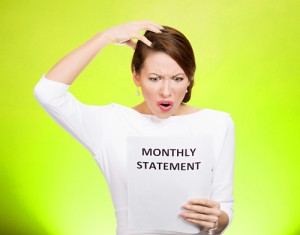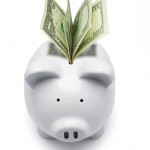
Have you ever been shocked by your credit card bill? Via Shutterstock.
We’ve written a lot about the danger of overspending on credit cards. We’ve shared our struggles with credit card spending, tips to choose the best credit card, and even offered advice on how to know if your child is ready for a credit card. Overspending is a fast track to debt, especially when combined with high interest rates. While understanding interest is extremely important, we haven’t explained it completely…until now.
How credit card interest works
What’s Revolving Credit? While some cards (such as American Express) require you to pay off all of your charges every month, most credit cards offer revolving credit. Revolving credit is when a bank or credit card allows you to continuously borrow money up until a certain limit. Then, you can either choose to pay off the whole balance (the safest option!), put down a partial payment, or pay the minimum balance (worst option!). The revolving balance, the balance left after your payment, is then charged interest. Basically, the credit card bank is charging you for borrowing their money. How much will they charge you? This depends on the interest rate of the card and how high the balance is. Paying the card balance in full each month is the ONLY way to avoid interest charges.
Simple Rate Interest vs. Compound Interest – For most of us, simple interest is what comes to mind when we think of interest. Simple interest is the amount of money borrowed times the interest rate. For example, 10% interest on $1,000 is $100. This is NOT the type of interest credit cards use. Credit cards use the method of compound interest which can be thought of as interest on interest. Compound interest is interest paid on previously earned interest on top of the principal loan.
Compound Interest Simplified – Compound interest sounds complicated BUT it’s easier to understand than you might think. As an example let’s pretend you have a revolving balance of $1,000 on your card and your monthly interest rate is 18.99%. If your interest is compounded monthly you would be charged 1.5825% interest on that $1,000. In the first month alone you would have accrued an extra $15.825 in interest! It’s easy to see how this could quickly add up…especially if you only make the minimum payment.
Annual Percentage Rate – The annual percentage rate (APR) is the amount of interest you will be charged on an annual basis. So, if your credit card has an APR of 18.99% (like mine!) that’s how much you pay on the balance you carry each month. Seems simple enough, right? Well, it can be more complicated. Most credit cards compound interest daily or monthly NOT annually. This means that your interest rate may actually be higher than your APR. The two main methods that cards use to charge interest are daily balance and daily compounding.
- Average Daily Balance – When cards use this method you are charged interest once a month, based on your average balance. All of your daily balances are added up and then divided by the number of days in your billing cycle. Here comes the trick…then this number is multiplied by your MONTHLY interest rate which is 1/12 of your APR. For example, if your APR is 18.99% than your monthly interest rate is 1.5825 %. That’s the number that your daily balance will be multiplied by. So, if your daily balance was $100 your interest would be $1.58.
- Daily Compounding – Other cards compound interest daily. That means they charge you interest daily. Each day, your interest is charged on your balance and added to your total. The intrest would then be your APR divided by 365. For example, it would be .05202% if your APR was 18.99%. If you had $1000 balance at the end of one day the charge for that day would be around $0.52. That $0.52 is then added to your balance and interest is charged on the total amount ($1000.52) the next day.
Do you think credit card interest is deceptive?








Leave a Reply